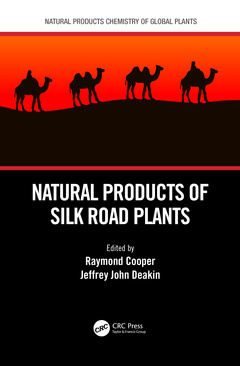Natural Products of Silk Road Plants Natural Products Chemistry of Global Plants Series
Coordonnateurs : Cooper Raymond, Deakin Jeffrey John

The Silk Road, a complex network of trade routes linking China with the rest of the Eurasian continent by land and sea, fostered transformation of the ethnic, cultural, and religious identities of diverse peoples. In Natural Products of Silk Road Plants there is a treasury of plants, many indigenous to countries along the trading routes of the Silk Road, that yielded medicines, cereals, spices, beverages, dyes, and euphoric and exotic compounds previously unknown to the rest of the world.
This entry in the Natural Products Chemistry of Global Plants series has been prepared for university students of chemistry and ethnobotany and for those wishing to broaden their knowledge. It opens a window on a vast region of Asia not well described for its flora and provides new and fresh insights on:
- Significant plants, some endangered
- Traditional and modern applications of extracts
- The biochemical and pharmacological properties of extracts
- Contains over 150 full colour figures
The significance of the Silk Road is being revived today through immense investment by China and other eastern countries in major schemes of transport infrastructure.
1. Medicinal Plants of Mongolia 2. Medicinal Plants of Tibet and the Surrounding Region 3. Medicinal Plants of the Trans-Himalayas 4. Medicinal Plants of Central Asia 5. Melons of Central Asia 6. Resources along the Silk Road in Central Asia: Lagochilus inebrians Bunge (Turkestan mint) and Medicago sativa L. (alfalfa) 7. An overview of important Endemic Plants and their Products in Iran 8. Crocus Sativus and the Prized Commodity, Saffron 9.Natural Plant Dyes of Oriental Carpets 10. Wheat and Rice – Ancient and Modern Cereals 11. Ethnobotany of the Silk Road – Georgia, the Cradle of Wine 12. Plants Endemic to Turkey including the Arnebia genus 13. Maritime Routes through Sri Lanka: Medicinal Plants and Spices
Raymond Cooper is a visiting professor at Hong Kong Polytechnic University. He earned his PhD in organic chemistry from the Weizmann Institute in Israel. His dissertation researched the ancient wild wheats of the Middle East, examining their germinating properties and chemical profiles. After completing a postdoctoral fellowship at Columbia University, New York, he spent 15 years in drug discovery research of plant and microbial natural products in the pharmaceutical and biotechnology industries. He then moved to the nutraceutical and dietary supplements industry to develop botanicals from traditional Chinese medicine including ginkgo, cordyceps, red yeast rice, green tea and many other botanical medicines. He is a Fellow of the Royal Society of Chemistry in the United Kingdom, an honorary visiting professor at the College of Pharmacy, University of London, and a member of the American Pharmacognosy Society. He has published over 120 research papers, edited five books and coauthored the book Natural Products Chemistry: Sources, Separations and Structures. He is an associate editor of the Journal of Alternative and Complementary Medicine and received the American Society of Pharmacognosy 2014 Varro Tyler Award for Contributions to Botanical Research.
Jeffrey Deakin earned a first class honors degree in chemistry from the University of London followed by a PhD in physical chemistry from the University of Cambridge. He has headed the chemistry and physics departments in grammar and comprehensive schools in the United Kingdom. He was a founding member and non-executive director of a multi-academy educational trust, formally approved by the Department for Education in the UK, which aims to secure and sustain school improvement by providing leadership and support, by working with governing bodies to strengthen their leadership and strategic delivery and through contracted work with school leaders and their teams. At the same time he was also the chairman of the
Date de parution : 09-2020
17.8x25.4 cm
Date de parution : 09-2020
17.8x25.4 cm
Thèmes de Natural Products of Silk Road Plants :
Mots-clés :
Essential Oil; Arnebia Euchroma; China's medicinal plants; Equisetum Arvense; Mongolia's medicinal plants; Silk Road; silk road ethnobotany; Maritime Silk Road; silk road geography; Hippophae Rhamnoides; Trans-Himalayas medicinal plants; Chemical Constituents; Sea Buckthorn; Rubia Tinctorum; Melon Cultivars; Isoquinoline Alkaloids; Podophyllum Hexandrum; Dang Gui; Melo Var; Rhodiola Rosea; Ethyl Acetate Extract; Saffron; Saffron Crocus; Treat Skin Conditions; Free Anthraquinones; Cinnamon Leaf Oil; Moist Soil; Cinnamomum Zeylanicum; Medicago Falcata; Punica Granatum
